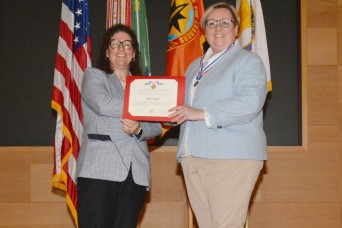INTRODUCTION
Deputy Assistant Secretary of the Army (Civilian Personnel) (DASA-CP) advises the Assistant Secretary of the Army (Manpower & Reserve Affairs) (ASA(M&RA)) and other senior leaders on all matters relating to human resources (HR) and lifecycle management for the Army Civilian workforce.
MISSION STATEMENT
The Deputy Assistant Secretary of the Army provides policy, supervision, and oversight of the Army’s human capital management for civilian personnel.
DASA-CP KEY INITIATIVES
1.Talent Management: Oversee and implement the CIP to modernize human capital practices.
2.Cyber Excepted Service: Oversee and implement the Cyber Excepted Service Personnel system to recruit and retain critical cyber talent.
3.Defense Performance and Appraisal Program: Institutionalize a culture of high performance.
4.Career Program Policy: Oversee policy and facilitate governance of Career Program management.
5. Data Analytics: Leverage robust data analytics to inform data-driven civilian human capital decisions.
6. Talent Acquisitions: Optimize and streamline the civilian hiring process.
7. Support Workforce through Special Projects: Use innovative personnel practices to support lethality, readiness and warfighting.
8. Civilian Fitness and Health Promotion Program: Provide oversight to enhance health fitness and quality of life for Army Civilians.
9. Employee Engagement: Institutionalize a culture of engagement at all levels of the workforce.
10. Expeditionary Civilian Workforce: Oversee deployment operations and support to enhance the warfighter’s capability and capacity.
11. Civilian Human Resources Delegations of Authorities: Streamline civilian personnel authorities to strengthen work effectiveness and efficiencies.
12. Army Civilian Recognition: Promote a culture of employee recognition for commendable Army service.
ARMY CIVILIAN CORPS CREED
DASA-CP ORGANIZATION CHART
-
ORG CHART GOES HERE
NEWS
-
 Watervliet Arsenal apprentice workshop goes live
December 31, 2025
Watervliet Arsenal apprentice workshop goes live
December 31, 2025
-
 Army Logistics Leaders Map Future Civilian Readiness Strategy
August 25, 2025
Army Logistics Leaders Map Future Civilian Readiness Strategy
August 25, 2025
-
 Financial management experts selected as 20th CBRNE Civilians of the Quarter
August 20, 2025
Financial management experts selected as 20th CBRNE Civilians of the Quarter
August 20, 2025
-
 Department of Defense recognizes TRADOC Army civilian with Spirit of Hope Award
August 7, 2025
Department of Defense recognizes TRADOC Army civilian with Spirit of Hope Award
August 7, 2025
-
 US Army civilian master aviator completes last flight at premier CBRNE command
July 31, 2025
US Army civilian master aviator completes last flight at premier CBRNE command
July 31, 2025
-
 CECOM ILSC recognizes Civilian Service Achievement Medal winners
July 22, 2025
CECOM ILSC recognizes Civilian Service Achievement Medal winners
July 22, 2025
-
 Army Reserve officer, LRC Italy civilian: our host nation employees - master professionals
July 3, 2025
Army Reserve officer, LRC Italy civilian: our host nation employees - master professionals
July 3, 2025
-
 CSM (R) Otis Smith Marks Half-Century of Service to Nation
July 2, 2025
CSM (R) Otis Smith Marks Half-Century of Service to Nation
July 2, 2025
-
 Army communications security manager recognized at premier CBRNE command
June 16, 2025
Army communications security manager recognized at premier CBRNE command
June 16, 2025
-
 Army civilian budget analyst recognized for service at chemical brigade on Fort Cavazos
June 9, 2025
Army civilian budget analyst recognized for service at chemical brigade on Fort Cavazos
June 9, 2025
-
 US Army civilian human resource specialist completes 35-year Army, civil service career
May 29, 2025
US Army civilian human resource specialist completes 35-year Army, civil service career
May 29, 2025
-
 Fort Campbell-based budget analyst selected as 20th CBRNE Command Civilian of the Year
May 13, 2025
Fort Campbell-based budget analyst selected as 20th CBRNE Command Civilian of the Year
May 13, 2025
INTRODUCTION
The Federal Employee Viewpoint Survey (FEVS) is an annual government-wide survey, administered by OPM, that measures employees’ perceptions of whether, and to what extent, conditions that characterize successful organizations are present in their agency.
The FEVS results provide valuable insights for Army leaders into the strengths and challenges within their workplaces. These results help ensure Army is creating and supporting conditions for an effective Civilian workforce. The FEVS is one of the best ways to provide feedback to Army leaders on how organizations are doing.
Confidentiality
- Access to completed surveys will be limited to OPM staff and contractors who are involved in collecting or preparing the information for analysis and agencies such as GAO that have specific authority to obtain agency records.
- In any public release of survey results, no data will be disclosed that could be used to identify specific individuals.
- Your agency will only receive summary reports for the whole population and for certain subgroups. Your agency will not receive data by subgroups that could be used to identify a specific individual or a person's specific response to a survey question.
BEST PLACES TO WORK
The Department of the Army was named one of the best places to work within the Federal government!
In May 2024, the Department of the Army ranked ninth for Large Agencies in the Partnerships for Public Service’s Best Places to Work Rankings. These rankings are primarily derived from the annual Federal Employee Viewpoint Survey (FEVS).
2024 FEVS SURVEY
The 2024 FEVS will be a full census. Employees must update their work email in the HR portal (MyBiz) to ensure receiving the survey. OPM is planning to administer the survey in early/mid-May.
Who is eligible to take the 2024 FEVS?
All federal employee onboarded by November 30, 2023, will receive an email invitation from the U.S. Office of Personnel Management (OPM) containing a unique link to participate in the survey. Political appointees, contractors/non-federal employees, and any employee who joined after November 30, 2023, are not eligible.
2023 FEVS: SUMMARY OF NOTABLE RESULTS
The Department of the Army's participation rate in the 2023 Federal Employee Viewpoint Survey (FEVS) stood at 27.6%, marking a 0.6 percentage point decrease from the 2022 rate of 28.2%. Notably, we exceeded the Department of Defense average by 4 points (23.7%) and surpassed all other service branches, including the Marine Corps, Navy, and Air Force.
We encourage HR leaders to leverage FEVS data to create action plans for their organization. More information can be found on the Microsoft Teams (Army FEVS Info) site.
2022 FEVS: Summary of Notable Results
The Army’s 2022 Federal Employee Viewpoint Survey (FEVS) results were broadly promising, with a modest uptick in employee engagement index (EEI) marking a return to our yearslong trend of improvement after a hiccup in the 2021 survey. No survey items fell into OPM’s “challenges” category—i.e., no question featured a negative response rate of higher than 35%—and two of the three major components of the EEI showed year-over-year improvement.
A summary of notable items in the 2022 FEVS results revealed that Army Civilians have a high level of confidence in their mission and that the Army has made important strides in areas that it has historically struggled—both promising signs as we work to improve the Army Civilian experience. Significant work remains, particularly in performance recognition, which should be a focus area for HR leaders as they develop action plans for 2023 and beyond.
CONTACT INFORMATION:
OPM has a FEVS Helpdesk to respond to all employee inquiries about the FEVS. All questions and inquiries about the survey, such as eligibility, confidentiality, and locating the survey invitations, should be directed to the helpdesk.
To reach the helpdesk, Army Civilians should email EVAR@OPM.GOV, and USACE should email EVAC@OPM.GOV.
FAQs
-
Who is eligible to take the FEVS survey? Non-political, non-contractor, non-Title X Army Civilians on board with the Army as of November 30, 2023, are eligible to complete the survey. All Army Civilians who meet the eligibility requirements will receive an invitation to complete the FEVS. Your work email address must be updated and current in the HR portal (MyBiz).
-
How long does the FEVS survey take?
The survey can be completed online and takes an average of 20 minutes to complete. -
What if I do not receive an invitation, but believe I am eligible?
Army Civilians should email armyfevshelp@army.mil with questions about eligibility. -
Why should I take the FEVS survey?
The survey results provide valuable insights to Army leaders on the strengths of the Civilian workforce, as well as gauging areas for improvement. OPM does not provide individual response data to any Army or Department of Defense official.
-
When do results come out?
The timeline of reports being released varies on OPM's annual rollout schedule. -
Where can additional information be found on FEVS?
For more information on FEVS, refer to the OPM website or contact your local FEVS representative.
2023 FEVS COMMUNICATIONS CAMPAIGN
2023 FEVS Communications Campaign















